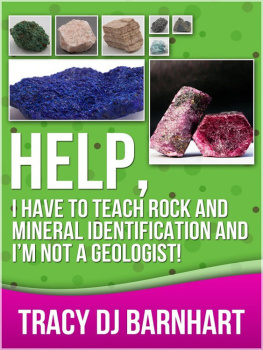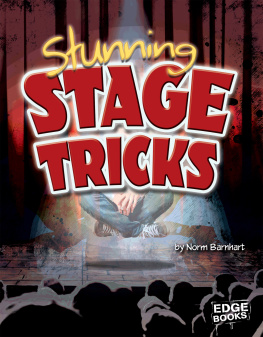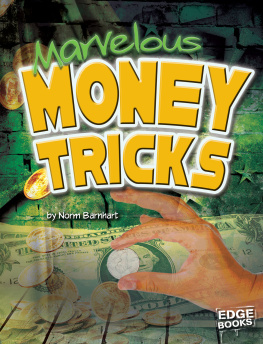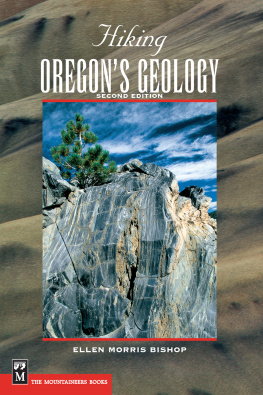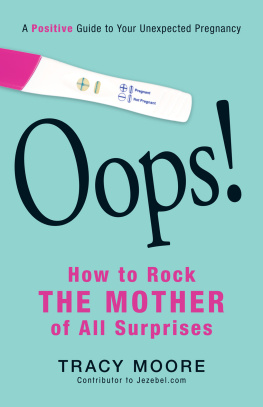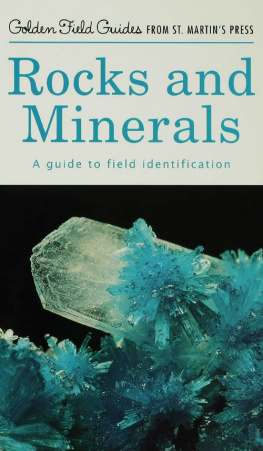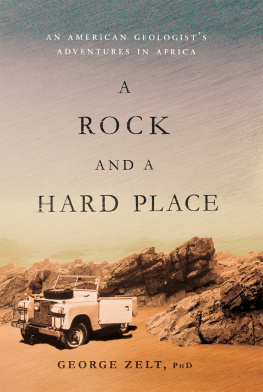Tracy Dj Barnhart - Help, I Have to Teach Rock and Mineral Identification and Im Not a Geologist!
Here you can read online Tracy Dj Barnhart - Help, I Have to Teach Rock and Mineral Identification and Im Not a Geologist! full text of the book (entire story) in english for free. Download pdf and epub, get meaning, cover and reviews about this ebook. year: 2020, genre: Children. Description of the work, (preface) as well as reviews are available. Best literature library LitArk.com created for fans of good reading and offers a wide selection of genres:
Romance novel
Science fiction
Adventure
Detective
Science
History
Home and family
Prose
Art
Politics
Computer
Non-fiction
Religion
Business
Children
Humor
Choose a favorite category and find really read worthwhile books. Enjoy immersion in the world of imagination, feel the emotions of the characters or learn something new for yourself, make an fascinating discovery.
- Book:Help, I Have to Teach Rock and Mineral Identification and Im Not a Geologist!
- Author:
- Genre:
- Year:2020
- Rating:3 / 5
- Favourites:Add to favourites
- Your mark:
- 60
- 1
- 2
- 3
- 4
- 5
Help, I Have to Teach Rock and Mineral Identification and Im Not a Geologist!: summary, description and annotation
We offer to read an annotation, description, summary or preface (depends on what the author of the book "Help, I Have to Teach Rock and Mineral Identification and Im Not a Geologist!" wrote himself). If you haven't found the necessary information about the book — write in the comments, we will try to find it.
Tracy Dj Barnhart: author's other books
Who wrote Help, I Have to Teach Rock and Mineral Identification and Im Not a Geologist!? Find out the surname, the name of the author of the book and a list of all author's works by series.
Help, I Have to Teach Rock and Mineral Identification and Im Not a Geologist! — read online for free the complete book (whole text) full work
Below is the text of the book, divided by pages. System saving the place of the last page read, allows you to conveniently read the book "Help, I Have to Teach Rock and Mineral Identification and Im Not a Geologist!" online for free, without having to search again every time where you left off. Put a bookmark, and you can go to the page where you finished reading at any time.
Font size:
Interval:
Bookmark:


Help, I Have to Teach Rock and Mineral Identification and Im Not a Geologist!
Tracy Barnhart
Published by Giverny Press, 2014.
The Definitive Guide for Teachers and Home School Parents for Teaching Rock and Mineral Identification to Elementary, Middle and High School Students
ISBN 978-0-9894112-1-9
Copyright 2014 by Tracy DJ Barnhart. All Rights Reserved.
All Rights Reserved. This book may not be reproduced, transmitted, or stored in whole or in part by any means, including graphic, electronic, or mechanical without the express written consent of the author and publisher except in the case of brief quotations of 50 words or less embodied in critical articles and reviews with proper citation. No part of this book may be repurposed for commercial sales other than by the original author and publisher.
The scanning, uploading, and distribution of this book via the Internet or via any other means without the permission of the author and publisher is illegal and punishable by law. Please purchase only authorized electronic editions, and do not participate in or encourage electronic piracy of copyrighted materials.
While the author has made every effort to provide accurate Internet addresses at the time of publication, neither the publisher nor the author assumes any responsibility for errors, or for changes that occur after publication. Further, the author and publisher do not have control over and do not assume any responsibility for third party websites or their content.
www.MiniMeGeology.com
www.TracyBarnhart.com
Welcome to Help, I Have to Teach Rock and Mineral Identification and Im Not a Geologist! I hope you find this book fun and informative. Not everyone who teaches rock and mineral identification is a geologist by trade, but that should not stop you from instilling a sense of wonder in your students about our Earth. This book will help you do just that.
I designed this book to give you the tools to explain rock and mineral identification to elementary, middle and high school students. The information in this book will allow you to customize your lessons and activities for different ages. This book is not based on any particular set of rocks or minerals so you can adapt the lessons to the samples you have on hand. If you need samples, I can help you choose the best set or loose samples for your activities.
If you have any questions about teaching rock and mineral identification, please contact me directly! My email is tracyb@minimegeology.com
Sincerely,
Tracy Barnhart, Owner
Giverny, Inc. / Mini Me Geology
1.1 Tips for Teaching Rock and Mineral Identification
1.2 How to Perform an Experiment
1.3 Tools of the Geologist
2.1 Crystal Shapes
2.2 Color
2.3 Luster
2.4 Streak
2.5 Mineral Density
2.6 Hardness
2.7 Cleavage and Fracture
2.8 Magnetism
2.9 Optical Properties
2.10 Calcite Fizz Test
2.11 Gemstones
2.12 Mineral Uses
2.13 Suggested Mineral Identification Exercises
3.1 Igneous Rock Formation
3.2 Volcanoes
3.3 Igneous Rock Textures
3.4 Color and Special Features of Igneous Rocks
3.5 Igneous Rock Uses
3.6 Suggested Igneous Rock Identification Exercises
4.1 Sedimentary Rock Formation
4.2 Sedimentary Rock Textures and Grain Sizes
4.3 Special Features of Sedimentary Rocks
4.4 Sedimentary Rock Uses
4.5 Suggested Sedimentary Rock Identification Exercises
5.1 Metamorphic Rock Formation
5.2 Types of Metamorphism
5.3 Metamorphic Rock Textures
5.4 Special Features of Metamorphic Rocks
5.5 Metamorphic Rock Uses
5.6 Suggested Metamorphic Rock Identification Exercises
6.1 The Rock Cycle Process
6.2 Suggested Rock Cycle Exercise
Mineral Identification Flow Chart
Igneous Rock Identification Flow Chart
Sedimentary Rock Identification Flow Chart
Metamorphic Rocks Identification Flow Chart
Mineral Property Record Sheet
Igneous Rock Property Record Sheet
Sedimentary Rock Property Record Sheet
Metamorphic Rock Property Record Sheet
Common Mineral Information
Common Igneous Rock Information
Common Sedimentary Rock Information
Common Metamorphic Rock Information
Children love rocks and minerals. They are the building blocks of our Earth and are fascinating to study and collect. There are hundreds of rocks and minerals in the world, giving students opportunities to study numerous varieties of samples. Geologists use a variety of tests and information to determine the name of a rock or mineral. Students can perform most of the tests in a classroom or at home, making science lessons fun and educational!
1.1 Tips for Teaching Rock and Mineral Identification
Identifying rock and mineral samples can seem daunting to students. Elementary students are experiencing rocks and minerals for the first time while middle and high schools students may have only limited knowledge from earlier grades. Teaching children the basic properties that distinguish minerals and rocks from one another can help students begin to understand the basic fundamentals of geology. Younger students may use simple sets of rocks and minerals to gain an understanding of the differences while middle and high school students can learn to identify multiple samples within a particular group, such as minerals, igneous rocks, metamorphic rocks and sedimentary rocks, or between groups at a more advanced level.
Tip #1: Use a hands-on learning method where you give the students physical samples they can touch and test. A picture or poster is not as effective at teaching as hands-on learning. Allow the children to test the samples without worrying about damaging the minerals or rocks. Some of the tests they will perform will scratch, rub or even break the samples but that is okay and is part of learning to identify the properties. In addition, make sure that the samples are pure or almost pure specimens so that the tests are accurate and do not confuse students with the presence of two or more rock or mineral types. If two or more mineral or rock types are present, the test results may be incorrect.
Tip #2: Supply the students with high quality, proper tools to use in the identification process. Black and white streak plates, hand lenses, pennies older than 1982, strong vinegar and metal paper clips are all useful for identification purposes. Ensure that younger students have proper supervision using household acids. The next section discusses details of some of the geologists tools that may be useful for your lessons.
Tip #3: Use flow charts that are easy to read with limited arrow options so the choices are obvious for very young students. Older students may use information sheets, posters and flow charts that have additional data about the most important properties of the rocks and minerals. Flow charts are helpful because they give students a specific pattern to follow when performing tests and eliminating possibilities as you move from one block to another across the chart. Older children often find information cards or sheets helpful because they can perform the tests in any manner they choose and use the process of elimination to determine the identity of an unknown mineral. For students who are very interested in additional information about the minerals they identify, a copy of a rock and mineral reference book might be fun for them to review. Mini Me Geology has a list of six fabulous rock and mineral information books on our blog that we recommend for students of varying ages and interests.
Font size:
Interval:
Bookmark:
Similar books «Help, I Have to Teach Rock and Mineral Identification and Im Not a Geologist!»
Look at similar books to Help, I Have to Teach Rock and Mineral Identification and Im Not a Geologist!. We have selected literature similar in name and meaning in the hope of providing readers with more options to find new, interesting, not yet read works.
Discussion, reviews of the book Help, I Have to Teach Rock and Mineral Identification and Im Not a Geologist! and just readers' own opinions. Leave your comments, write what you think about the work, its meaning or the main characters. Specify what exactly you liked and what you didn't like, and why you think so.

